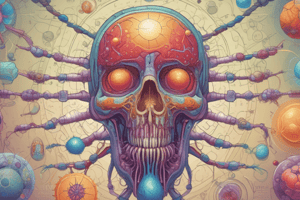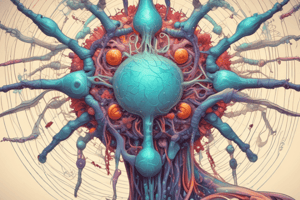Podcast
Questions and Answers
What is the primary function of the immune system?
What is the primary function of the immune system?
- To initiate inflammation
- To defend the body against infection and disease (correct)
- To produce antibodies
- To recognize and respond to specific antigens
What type of immunity provides immediate, non-specific defense against pathogens?
What type of immunity provides immediate, non-specific defense against pathogens?
- Cell-mediated immunity
- Adaptive immunity
- Innate immunity (correct)
- Humoral immunity
What is the main function of T-cells?
What is the main function of T-cells?
- To engulf and digest foreign particles and pathogens
- To produce antibodies
- To initiate inflammation
- To recognize and respond to antigens presented by antigen-presenting cells (correct)
What is the primary function of B-cells?
What is the primary function of B-cells?
What is the role of dendritic cells in the immune response?
What is the role of dendritic cells in the immune response?
What is the primary function of neutrophils?
What is the primary function of neutrophils?
What is the result of the activation phase of the immune response?
What is the result of the activation phase of the immune response?
What is the role of regulatory T-cells in the immune response?
What is the role of regulatory T-cells in the immune response?
Flashcards are hidden until you start studying
Study Notes
Immune System
- The immune system is a complex network of cells, tissues, and organs that defend the body against infection and disease.
- It consists of two main branches: innate immunity and adaptive immunity.
Innate Immunity
- Provides immediate, non-specific defense against pathogens.
- Involves physical barriers (skin, mucous membranes), cellular components (neutrophils, macrophages), and chemical mediators (complement system).
- Recognizes pathogens through pattern recognition receptors (PRRs).
Adaptive Immunity
- Provides specific, long-term defense against pathogens.
- Involves activation of T-cells and B-cells, which recognize and respond to specific antigens.
- Involves antibody production and immune memory.
Cells of the Immune System
- T-cells (T-lymphocytes):
- Recognize and respond to antigens presented by antigen-presenting cells (APCs).
- Types: CD4+ (helper T-cells), CD8+ (cytotoxic T-cells), and regulatory T-cells.
- B-cells (B-lymphocytes):
- Produce antibodies against specific antigens.
- Activate to become plasma cells, which secrete antibodies.
- Dendritic cells:
- Recognize and process antigens, presenting them to T-cells.
- Activate T-cells and initiate immune response.
- Macrophages:
- Engulf and digest foreign particles and pathogens.
- Present antigens to T-cells.
- Neutrophils:
- Destroy pathogens through phagocytosis and degranulation.
Immunoglobulins (Antibodies)
- Produced by B-cells in response to antigen exposure.
- Recognize and bind to specific antigens.
- Types: IgA, IgD, IgE, IgG, and IgM.
Immune Response
- Activation:
- Recognition of antigens by PRRs or antigen-presenting cells.
- Activation of T-cells and B-cells.
- Effector:
- Elimination of pathogens through antibody production and cell-mediated cytotoxicity.
- Regulation:
- Regulation of immune response through cytokines, regulatory T-cells, and immune suppression.
Immunological Disorders
- Autoimmune disorders:
- Immune system attacks self-antigens.
- Examples: rheumatoid arthritis, lupus, and multiple sclerosis.
- Immunodeficiency disorders:
- Impaired immune function.
- Examples: HIV/AIDS, primary immunodeficiency diseases.
- Allergies:
- Overactive immune response to harmless antigens.
- Examples: hay fever, food allergies, and asthma.
Immune System
- A complex network of cells, tissues, and organs that defends the body against infection and disease.
Innate Immunity
- Provides immediate, non-specific defense against pathogens.
- Involves physical barriers (skin, mucous membranes) and cellular components (neutrophils, macrophages).
- Recognizes pathogens through pattern recognition receptors (PRRs).
- Chemical mediators include the complement system.
Adaptive Immunity
- Provides specific, long-term defense against pathogens.
- Involves activation of T-cells and B-cells, which recognize and respond to specific antigens.
- Involves antibody production and immune memory.
Cells of the Immune System
- T-cells (T-lymphocytes):
- Recognize and respond to antigens presented by antigen-presenting cells (APCs).
- Types: CD4+ (helper T-cells), CD8+ (cytotoxic T-cells), and regulatory T-cells.
- B-cells (B-lymphocytes):
- Produce antibodies against specific antigens.
- Activate to become plasma cells, which secrete antibodies.
- Dendritic cells:
- Recognize and process antigens, presenting them to T-cells.
- Activate T-cells and initiate immune response.
- Macrophages:
- Engulf and digest foreign particles and pathogens.
- Present antigens to T-cells.
- Neutrophils:
- Destroy pathogens through phagocytosis and degranulation.
Immunoglobulins (Antibodies)
- Produced by B-cells in response to antigen exposure.
- Recognize and bind to specific antigens.
- Types: IgA, IgD, IgE, IgG, and IgM.
Immune Response
- Activation:
- Recognition of antigens by PRRs or antigen-presenting cells.
- Activation of T-cells and B-cells.
- Effector:
- Elimination of pathogens through antibody production and cell-mediated cytotoxicity.
- Regulation:
- Regulation of immune response through cytokines, regulatory T-cells, and immune suppression.
Immunological Disorders
- Autoimmune disorders:
- Immune system attacks self-antigens.
- Examples: rheumatoid arthritis, lupus, and multiple sclerosis.
- Immunodeficiency disorders:
- Impaired immune function.
- Examples: HIV/AIDS, primary immunodeficiency diseases.
- Allergies:
- Overactive immune response to harmless antigens.
- Examples: hay fever, food allergies, and asthma.
Studying That Suits You
Use AI to generate personalized quizzes and flashcards to suit your learning preferences.




